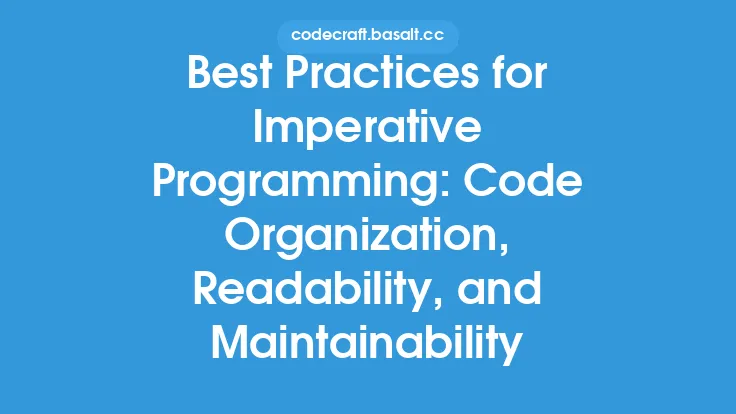Improving software quality is a crucial aspect of software engineering, and code review plays a significant role in achieving this goal. Code review is a systematic examination of computer source code, intended to find and fix mistakes, and improve the overall quality of the code. In this article, we will discuss the best practices for code review that can help improve software quality.
Introduction to Code Review
Code review is an essential part of the software development process. It involves reviewing the code written by a developer to ensure that it meets the required standards, is free from errors, and is maintainable. Code review can be performed manually or using automated tools. Manual code review involves a human reviewer examining the code, while automated code review uses tools to analyze the code and identify issues. Code review can be performed at various stages of the software development process, including during development, before deployment, and after deployment.
Benefits of Code Review
Code review has several benefits, including improved code quality, reduced bugs, and improved maintainability. Code review helps to ensure that the code is readable, maintainable, and follows the required standards. It also helps to identify and fix errors, which can reduce the number of bugs in the code. Additionally, code review can help to improve the overall design of the code, making it more efficient and scalable. Code review also promotes knowledge sharing and collaboration among developers, which can lead to improved team performance and productivity.
Code Review Process
The code review process typically involves the following steps:
- Code submission: The developer submits the code for review.
- Code review: The reviewer examines the code and identifies issues.
- Feedback: The reviewer provides feedback to the developer.
- Revision: The developer revises the code based on the feedback.
- Re-review: The reviewer re-examines the revised code.
The code review process can be iterative, with multiple rounds of review and revision until the code meets the required standards.
Code Review Best Practices
To get the most out of code review, it's essential to follow best practices. Here are some code review best practices:
- Keep it small: Review small chunks of code at a time to ensure that the reviewer can focus on the details.
- Be thorough: Review the code thoroughly, checking for errors, inconsistencies, and areas for improvement.
- Use checklists: Use checklists to ensure that the reviewer covers all aspects of the code.
- Provide constructive feedback: Provide feedback that is constructive and actionable, helping the developer to improve the code.
- Use version control: Use version control systems to track changes and collaborate with other developers.
- Review regularly: Review code regularly, ideally as part of the development process.
- Involve multiple reviewers: Involve multiple reviewers to get different perspectives and catch more issues.
Code Review Tools
There are many code review tools available, both open-source and commercial. Some popular code review tools include:
- Git: Git is a version control system that includes code review features.
- GitHub: GitHub is a web-based platform for version control and code review.
- Bitbucket: Bitbucket is a web-based platform for version control and code review.
- Crucible: Crucible is a code review tool that integrates with version control systems.
- Gerrit: Gerrit is a code review tool that integrates with version control systems.
Code Review Metrics
To measure the effectiveness of the code review process, it's essential to track metrics. Some common code review metrics include:
- Code coverage: Code coverage measures the percentage of code that is reviewed.
- Defect density: Defect density measures the number of defects per unit of code.
- Review time: Review time measures the time it takes to review the code.
- Review frequency: Review frequency measures how often code is reviewed.
- Developer participation: Developer participation measures the number of developers involved in the code review process.
Code Review and Testing
Code review and testing are closely related. Code review can help to identify issues that can be caught by testing, and testing can help to validate the code review process. There are several types of testing, including:
- Unit testing: Unit testing involves testing individual units of code.
- Integration testing: Integration testing involves testing how different units of code work together.
- System testing: System testing involves testing the entire system.
- Acceptance testing: Acceptance testing involves testing the system to ensure it meets the requirements.
Code Review and Refactoring
Code review and refactoring are also closely related. Refactoring involves improving the design and structure of the code without changing its behavior. Code review can help to identify areas of the code that need refactoring, and refactoring can help to improve the overall quality of the code. There are several types of refactoring, including:
- Renaming: Renaming involves changing the names of variables, methods, and classes to make them more descriptive.
- Extracting methods: Extracting methods involves breaking down long methods into smaller, more manageable pieces.
- Removing duplicates: Removing duplicates involves removing duplicate code to make the code more maintainable.
- Simplifying conditionals: Simplifying conditionals involves simplifying complex conditional statements to make the code more readable.
Conclusion
In conclusion, code review is a crucial aspect of software engineering that can help improve software quality. By following best practices, using code review tools, and tracking metrics, developers can ensure that their code is of high quality, maintainable, and efficient. Code review is closely related to testing and refactoring, and by combining these practices, developers can create high-quality software that meets the required standards.





